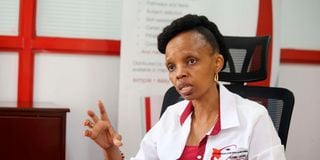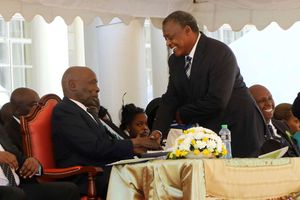Premium
Kuccps sets June 7, as deadline for first course revision window

KUCCPS Chief Executive Officer Agnes Mercy Wahome.
What you need to know:
- Students will be placed in programmes based on their performance and available capacities in institutions of higher learning.
- The model aims to radically shift government support for higher education from automatic grants, to student loans sustained by a revolving fund and scholarships.
Students who wish to apply for placement or revise their university and college choices have until Wednesday this week, to access the Kenya Universities and Colleges Central Placement Service (Kuccps).
The portal, which was opened on May 17, 2023, will be closed on Wednesday to allow for simulation by the agency. Students will be placed in programmes based on their performance and available capacities in institutions of higher learning.
The portal will be reopened for the second revision for 12 days from June 19 to 30, 2023. Students who will not have secured their preferred courses or institutions will get another chance to apply for alternatives.
Thereafter, there will be another one-week simulation before the portal is opened for the third and final revision from July 10 to 14, 2023. The final simulation will follow and then the students will get their placement results on August 9, 2023.
According to Kuccps boss Agnes Mercy Wahome, 90 per cent of students who qualify for university admission apply for placement. Out of the 173,127 students who scored C+ and above in the 2022 Kenya Certificate of Secondary Education (KCSE) examination, the agency expects about 155,000 to apply and take up their university places.
The application process is significantly different this year from other years in compliance with the new funding model.
Under the new dispensation, the government has shifted from the differentiated unit cost model to fund students directly through a mix of scholarships, loans and bursaries as opposed to the capitation that would be sent to universities.
All universities participating in the centralised placement have indicated the cost of all their programmes on the Kuccps portal, so that students make applications taking into consideration the cost their families will have to bear.
“The universities must attract students. The courses offered must also have a relationship with the job market. We want to put more money in loans, and the ultimate goal is to have university education funded at 80 per cent loans, and 20 per cent scholarship,” Dr Wahome said.
Students from families categorised as less needy will pay more for university education in the new funding model that has been described as pro-hustler as the vulnerable get full government scholarships, loans and bursaries.
The model aims to radically shift government support for higher education from automatic grants, to student loans sustained by a revolving fund and scholarships.
The model will be jointly implemented by three agencies in the higher education sector. These are Kuccps, the Higher Education Loans Board and the Universities Fund.
“In this model, the poor get the least in terms of loans, but more in scholarship while the less needy get higher loans and less scholarship. If we burden the already poor with huge loans at the end of their studies, it becomes a lifetime responsibility. I see a lot of stability in the next five years and an increase in the quality of education. We’ll see a revolution in higher education,” said University Fund CEO Geoffrey Monari.
After the results are released on the portal, students will download their admission letters from the respective institutions they will be placed in.
Dr Wahome said that Kuccps will allow for inter-institutional transfers between August 14 and 31, 2023. Students are allowed only one transfer and these can only happen during the first year of study.
The 2022 KCSE exam had 869,782 candidates sitting. There are 39 public universities, 33 private universities, three secondary teachers training colleges and 205 public technical and vocational education and training colleges that have displayed the courses on offer on the Kuccps portal.
The programmes range from degree, diploma, craft certificate to artisan courses, and the students will be placed depending on their choice and performance in their KCSE exam.





